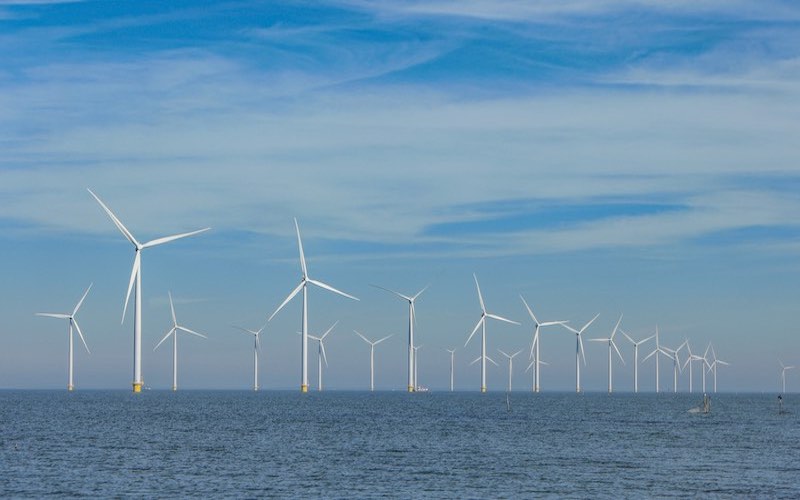
Photo: Shutterstock
Update, January 2022: Vineyard Wind, LLC, NRDC, CLF and NWF are proud of the work put into the landmark agreement we signed in 2019. It laid the foundation for important mitigation measures. Now that the project has received its approvals, the parties have decided that the relevant state and federal permits govern the mitigation requirements for the Vineyard Wind 1 project.
January 23, 2019 (BOSTON) – Vineyard Wind and the Natural Resources Defense Council, the National Wildlife Federation, and Conservation Law Foundation today entered into an unprecedented agreement to protect critically endangered North Atlantic right whales.
Under the historic agreement, Vineyard Wind will institute a variety of protective measures to keep right whales safe while installing and operating turbines at its proposed 84-turbine project off the coast of Massachusetts. Harnessing offshore wind is a key step in transitioning the nation away from dirty, polluting fossil fuels to a clean energy economy.
“Scaling up offshore wind in wildlife-friendly ways is essential to confronting the climate crisis,” said Collin O’Mara, president and CEO of the National Wildlife Federation. “By ensuring that offshore wind power is responsibly built and operated, this model agreement is a win-win for conserving wildlife and creating well-paying jobs. We are proud to work with Vineyard Wind and our conservation partners to protect endangered North Atlantic right whales as this critically needed new clean energy industry takes off in the United States.”
Turbine construction will be curtailed in the winter and early spring when the North Atlantic right whales may be in the area, and there will be comprehensive monitoring to ensure that construction doesn’t take place when the whales are near the site. Vineyard Wind will dampen construction noise that disturbs the whales’ ability to communicate, find food and stay on their migratory path. The agreement also includes strict vessel speed limits.
“This innovative agreement is proof that we can grow the clean energy we need to power our homes and businesses and at the same time protect vulnerable wildlife like the iconic North Atlantic right whale,” said Nathanael Greene, Senior Renewable Energy Advocate at NRDC.
“As we ask more of our oceans, we must ensure that we balance the critical need for clean energy with the protection of our majestic right whales and other marine species,” added Dr. Priscilla Brooks, Director of Ocean Conservation at CLF. “This agreement marks a significant step forward in responsible development of offshore wind energy.”
Learn more by reading the full agreement.
When complete, the Vineyard Wind facility will consist of more than 80 turbines capable of generating 800 megawatts of electricity, enough power for more than 400,000 homes.
“Throughout development of the project, Vineyard Wind has strived to work with all stakeholders to proactively resolve potential issues and design the best project possible. It has been especially gratifying to work with these leading environmental groups in developing enhanced protections for right whales during all phases of what will be the nation’s first utility-scale offshore wind project,” said Erich Stephens, Chief Development Officer of Vineyard Wind.
Vineyard Wind will further invest $3 million to develop and deploy innovative technologies and undertake scientific research to further safeguard the marine mammals.
Barely 400 right whales remain on the planet. For decades, the North Atlantic right whale has been harmed by many existing marine uses, including entanglement with fishing gear and vessel collisions. The right whale protections announced today provide an important template other offshore wind projects should consider.
This agreement comes at a pivotal moment: After nearly 30 years of commercial advancement in Europe, U.S. offshore wind development is poised to surge over the next decade. While only five offshore wind turbines are operating now on this side of the Atlantic, states are mobilizing to bring offshore wind power online. Collectively these states have committed to develop 15 GW of offshore wind power, enough to provide clean, renewable power for 5 million homes.
# # #
The Natural Resources Defense Council (NRDC) is an international nonprofit environmental organization with more than 3 million members and online activists. Since 1970, our lawyers, scientists, and other environmental specialists have worked to protect the world’s natural resources, public health, and the environment. NRDC has offices in New York City, Washington, D.C., Los Angeles, San Francisco, Chicago, Bozeman, MT, and Beijing. Visit us at www.nrdc.org and follow us on Twitter @NRDC.
Conservation Law Foundation protects New England’s environment for the benefit of all people. We use the law, science, and the market to create solutions that preserve our natural resources, build healthy communities, and sustain a vibrant economy. CLF has taken action to protect right whales for decades, from successfully fighting oil and gas drilling within whales’ habitats, to ensuring offshore wind projects don’t cause harm, to taking on the federal government to protect whales from threats posed by commercial fishing gear. Learn more at www.clf.org
The National Wildlife Federation is America’s largest conservation organization, uniting all Americans to ensure wildlife thrive in a rapidly changing world. Follow our efforts to promote responsibly developed offshore wind power online or visit the National Wildlife Federation online at nwf.org and follow us on Facebook, Twitter, and Instagram.
